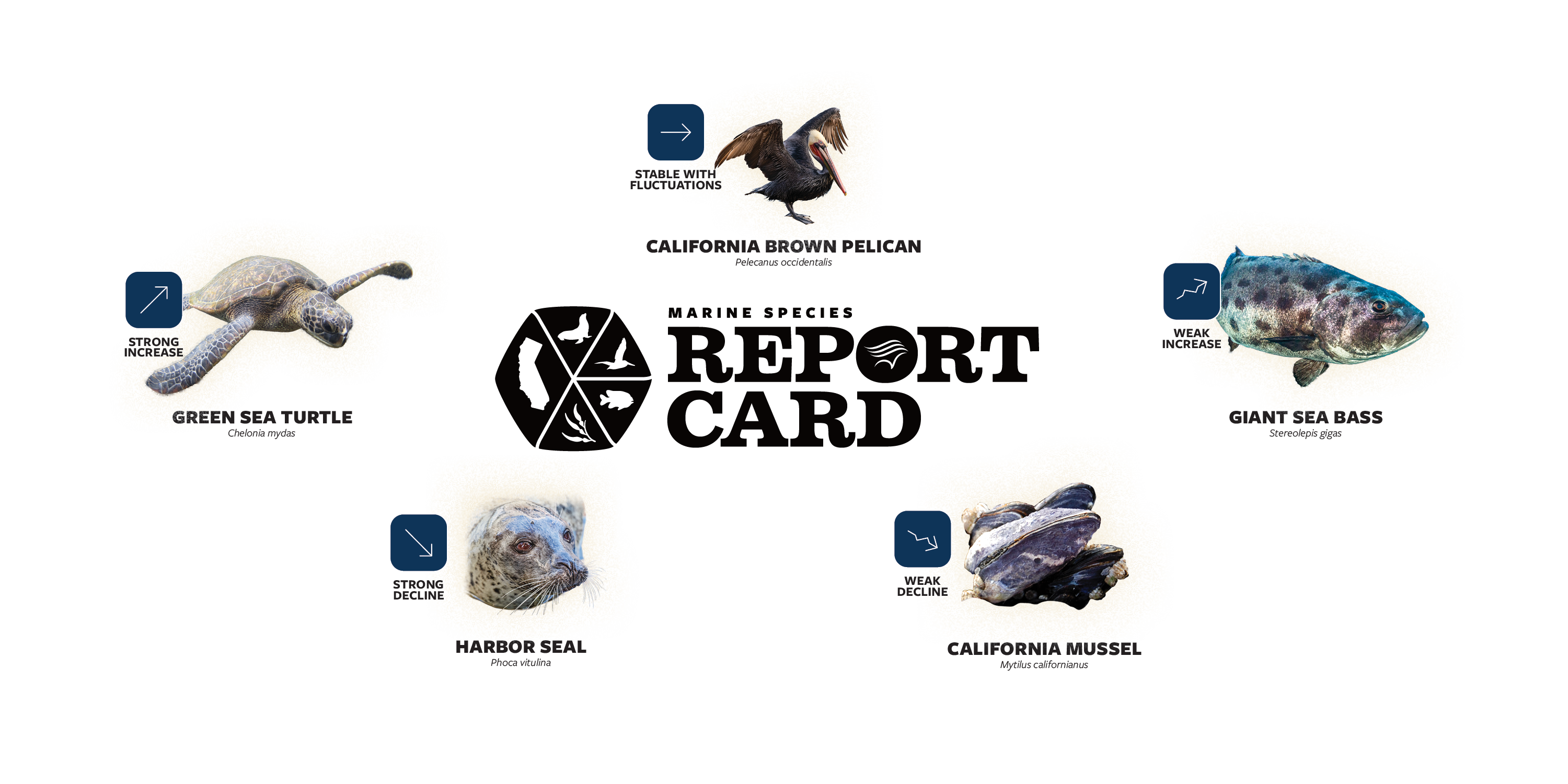
Marine Species Report Card
A first-of-its-kind Report Card serves as a resource to better understand and motivate protection for key marine species in Southern California
Known as the king of the kelp forest, the iconic giant sea bass was once abundant off our coast. But their docile nature and large size made them the prized catch. Years of overfishing decimated their populations by the 1970s. To save them from impending extinction, they were officially protected in the 1980s.
Monitoring and other efforts by government agencies, non-profits like the Aquarium of the Pacific, and even the diving community helped us see their slow but steady recovery. Protections proved successful in bringing back the giant sea bass from the edge of extinction.
Knowing which species need this type of intervention requires knowledge of their population. Just like in the case of this gentle giant, if we know a species is declining, we can take action that can make a difference in their survival.
While an abundance of monitoring exists for our local habitats for air and water quality, comparatively little is known on how individual species are faring in the face of climate change and other threats. Understanding the population of individual species is key…allowing us to take action before it reaches the brink of extinction.
Conservation for Local Species with the Report Card
The Aquarium of the Pacific has become a steward of the natural world in our own community through inspiring, educational exhibits and a variety of conservation programs from sea turtle rehabilitation and release to caring for rescued sea otters. To further our conservation efforts and meet this important informational need on local species, the Aquarium launched its first Marine Species Report Card on February 6.
The report card combines the work of scientists, researchers, government agencies, and others to assess the status of thirty key California coastal species.
The list includes marine mammals, birds, invertebrates (animals without backbones), fish, kelp, and more. The report card is on the Aquarium’s website with photos, facts about the species, information on the threats they face, and an arrow icon that indicates the population trend of each animal and whether it is increasing, declining, or stable.
To create this in-depth report card, the Aquarium formed a team of collaborators from more than a dozen institutions. The report assesses the individual species population trend through publicly available, index site monitoring and is supplemented by stories on the effectiveness of legislation like the Endangered Species Act of 1973, the establishment of marine protected areas, and other protections.
In-Depth Information on Animal Species
Each page outlines threats affecting each species based on peer-reviewed literature. Threats include climate impacts, habitat loss and degradation, food web imbalance, human disturbance and harassment, pollution and disease, and extraction. The most widespread threats across the thirty species are under two categories: climate impacts and pollution/disease.
Among the species covered, several provide interesting stories on threats, successes, and failures, and what we can do to help.
Southern sea otters, gray whales, and the California brown pelican have experienced a significant recovery and are among the eighteen out of the thirty species on the report card with population trends that are either stable or increasing.
Twelve out of the thirty species on the list are experiencing population trend declines that are cause for concern and further protection. These include giant kelp, bull kelp, sunflower sea stars, and white and black abalone. The Aquarium has been working to help many of these species. Some of our conservation projects include growing and outplanting endangered white abalone and for future restoration efforts in the wild, preserving bull kelp and raising baby sunflower sea stars.
Restoring California’s Coastal Ecosystem
The report card serves as a valuable tool for the public and policy makers, especially students and teachers, to better understand our ocean neighbors and serve as a motivation for sustained protection measures.
Our hope is that this resource will inspire people to support conservation efforts in a variety of areas from engaging in science to promoting environmental legislation.
To assess changes to populations of species, long-term monitoring programs are vital as are programs to restore California’s coastal ecosystems. The species depend on the habitats they live in, and we—as people—depend on these species. With knowledge is power…power to save a species before it reaches a critical point.
To learn more, visit the Marine Species Report Card online and visit the Aquarium to see over a dozen of the species included in the report, including the iconic giant sea bass that proves nature can recover with a little knowledge and a helping hand.
Download accessible version of this article’s Marine Species Report Card infographic.